
The Battle of Kleidion took place on July 29, 1014 between the Byzantine Empire and the Bulgarian Empire. It was the culmination of the nearly half-century struggle between the Byzantine Emperor Basil II and the Bulgarian Emperor Samuil in the late 10th and early 11th centuries. The result was a decisive Byzantine victory.

The Balkan mountain range is a mountain range in the eastern part of the Balkan Peninsula. The Balkan range runs 560 km from the Vrashka Chuka Peak on the border between Bulgaria and Serbia eastward through central Bulgaria to Cape Emine on the Black Sea. The highest peaks of the Balkan Mountains are in central Bulgaria. The highest peak is Botev at 2,376 m, which makes the mountain range the third highest in the country, after Rila and Pirin. The mountains are the source of the name of the Balkan Peninsula.
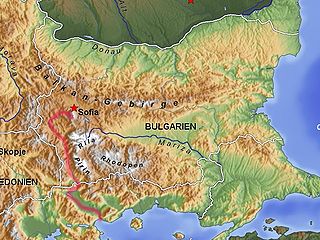
The Struma or Strymónas is a river in Bulgaria and Greece. Its ancient name was Strymṓn. Its drainage area is 17,330 km2 (6,690 sq mi), of which 10,797 km2 (4,169 sq mi) in Bulgaria, 6,295 km2 (2,431 sq mi) in Greece and the rest in the Republic of Macedonia. It takes its source from the Vitosha Mountain in Bulgaria, runs first westward, then southward, forming a number of gorges, enters Greek territory at the Kula village. In Greece it is the main waterway feeding and exiting from Lake Kerkini, a significant centre for migratory wildfowl. The river flows into the Strymonian Gulf in Aegean Sea, near Amphipolis in the Serres regional unit. The river's length is 415 kilometres.

The Ausable River, also known as AuSable River and originally written as "Au Sable", runs in the U.S. state of New York, from the Adirondack Mountains and past the village of Lake Placid and Au Sable Forks to empty into Lake Champlain. It has an East and West branch that join at Au Sable Forks. The river forms a partial boundary between Clinton County and Essex County. The Ausable River is known for its gorge, Ausable Chasm, located a few miles east of Keeseville.

Sandanski is a town and a recreation centre in south-western Bulgaria, part of Blagoevgrad Province. Named after revolutionary Yane Sandanski, it is situated in a valley at the foot of Pirin Mountains, along the banks of Sandanska Bistritsa River. Sandanski is about 20 km away from Bulgaria-Greece border and 100 km away from Aegean sea.

Simitli also known as Simitliya, is a town in Blagoevgrad Province in southwestern Bulgaria. It has a population of 7,454 and is located 17 km south of Blagoevgrad. It is the seat of Simitli Municipality.

The Maedi were a Thracian tribe in antiquity. In historic times, they occupied the area between Paionia and Thrace, on the southwestern fringes of Thrace, along the middle course of the Strymon, between the Kresna Gorge and the Rupel Pass. Strabo says that the Maedi bordered eastward on the Thunatae of Dardania, and that the Axius flowed through their territory.

The Iskar is a right tributary of the Danube. With a length of 368 km it is the longest river that runs entirely within Bulgaria. Originating as three forks in Balkan's highest mountain range Rila, it flows in northern direction until its confluence with the Danube River. As it flows northwards it fuels the largest artificial lake in the country, the Iskar Reservoir, forms the divide between the Vitosha and Plana Mountains in the west and the Sredna Gora mountain range in the east before entering the Sofia Valley, which contains the nation's capital Sofia. From there the Iskar runs through the Balkan Mountains forming the spectacular 84 km long Iskar Gorge and as it crosses the mountains its water course turns in north-eastern direction at Lakatnik. North of the Balkan Mountains the river crosses the Danubian Plain and finally flows into the Danube between the villages of Baykal and Gigen. Geologically, Iskar is the oldest river in the Balkan Peninsula.

The Nestos or Mesta, formerly the Mesta Karasu, is a river in Bulgaria and Greece. It rises in the Rila Mountains and flows into the Aegean Sea near the island of Thasos. It plunges down towering canyons toward the Aegean Sea through mostly metamorphic formations. At the end, the main stream spreads over the coastal plain of Chrysoupolis and expands as a deltaic system with freshwater lakes and ponds forming the Nestos delta.The length of the river is 230 km (140 mi), of which 126 km (78 mi) flow through Bulgaria and the rest in Greece. Its drainage area is 5,184 km2 (2,002 sq mi), of which 66% in Bulgaria. It forms some gorges in Rila and Pirin.

The Trigrad Gorge is a canyon of vertical marble rocks in the Rhodope Mountains. It is in Smolyan Province, one of the southernmost provinces of Bulgaria.
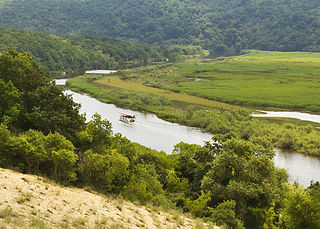
The Ropotamo is a river in south-eastern Bulgaria. It takes its source from the Bosna Ridge in the Strandzha Mountains, running for 48.5 km to empty into the Black Sea near Cape Saint Demetrius between Dyuni and Primorsko.

The Jerma or Erma is a river in southeastern Serbia and western Bulgaria. Though not very long (72 km), it is notable for passing the Serbian-Bulgarian border twice.
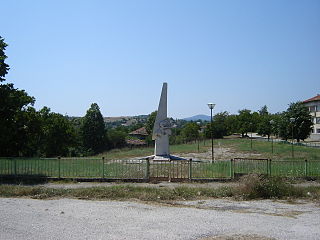
Chernichevo is a village in southern Bulgaria, located in the municipality of Krumovgrad in the Kardzhali Province. It is situated in the Eastern part of Rhodope Mountains, near the border with Greece. Its original Bulgarian name is "Dunyata". The correct geographical location of Chernichevo is 41° 21' N, 25° 47' E.
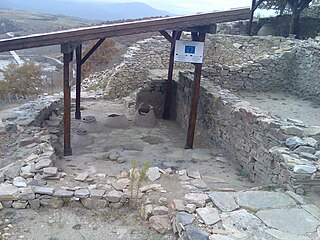
Hadzhidimovo is a small town and the centre of Hadzhidimovo Municipality in Blagoevgrad Province, south-western Bulgaria.

Kresna is a town and the seat of Kresna Municipality in Blagoevgrad Province in Bulgaria.
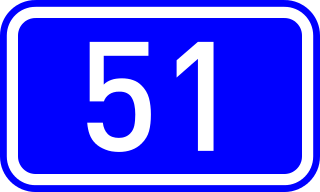
Greek National Road 51 is a single carriageway road in northeastern Greece. It connects the Greek National Road 2 near Feres with the Bulgarian border near Ormenio. The main towns on the GR-51 are Didymoteicho and Orestiada. The entire GR-51 is part of the European route E85. Its length is about 128 km. It runs from south to north, parallel to the river Evros.

Lehovo is a village in the municipality of Sandanski, in Blagoevgrad Province, southwestern Bulgaria.
The Bulgarian Second Army was a Bulgarian field army during the Balkan Wars, World War I, and World War II.
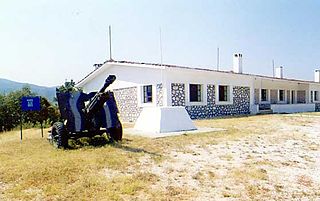
Fort Roupel is a fortress at the north border of Central Macedonia, Greece, built in 1914. It became part of the fortifications of the Metaxas Line in the 1930s and became famous for its defence during the German invasion of Greece in April 1941.
Makaza, previously also known as Balkan Toresi, is a mountain pass in the Eastern Rhodope Mountains, connecting southernmost central Bulgaria with north-easternmost Greece and thus the regions of Northern and Western Thrace. The Makaza pass forms part of Pan-European Corridor IX, connecting Helsinki in Finland with the Greek port of Alexandroupolis on the Aegean Sea. The international border between Bulgaria and Greece lies at the highest point of the pass, at 468 metres (1,535 ft) above sea level.




















